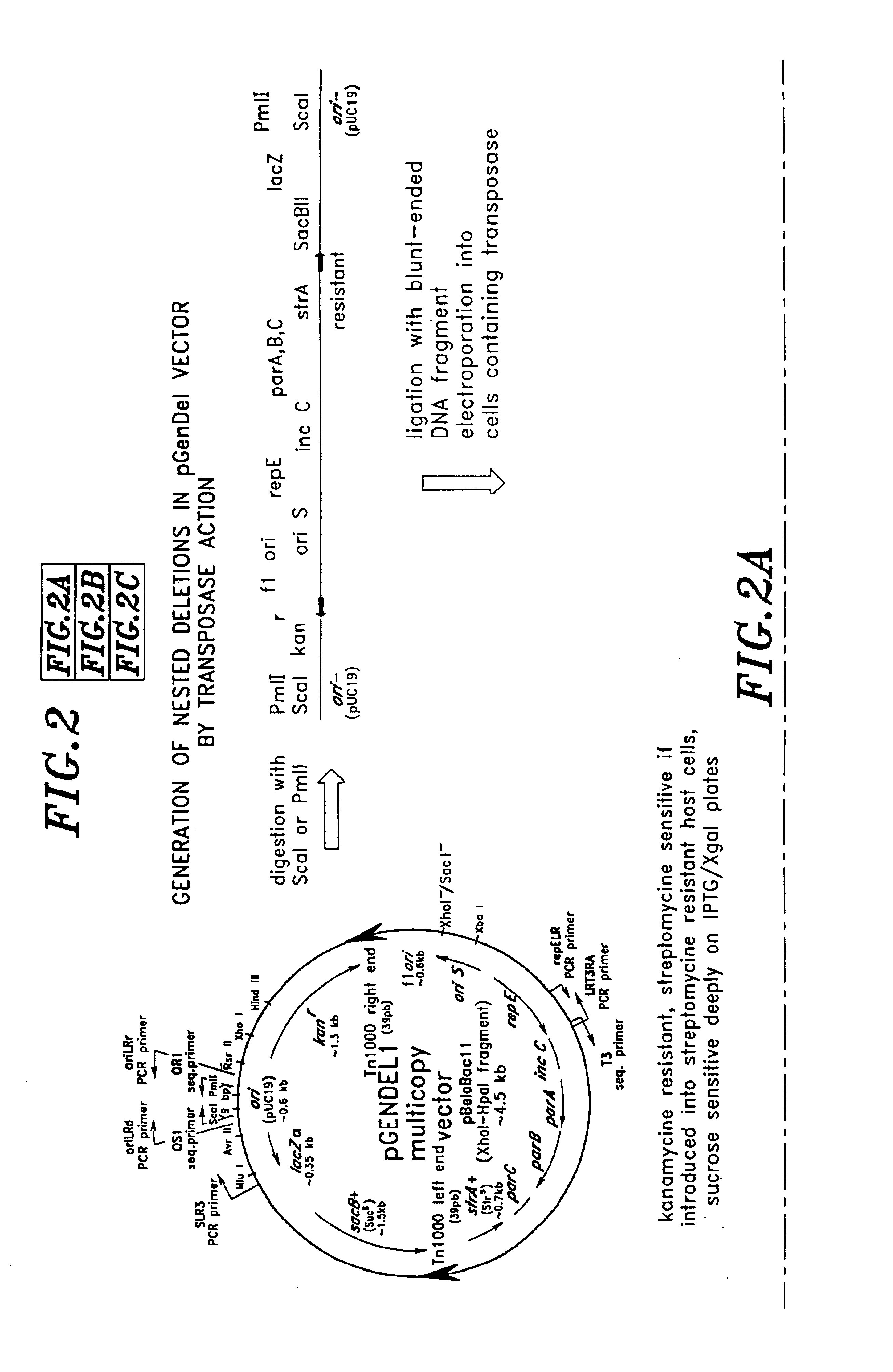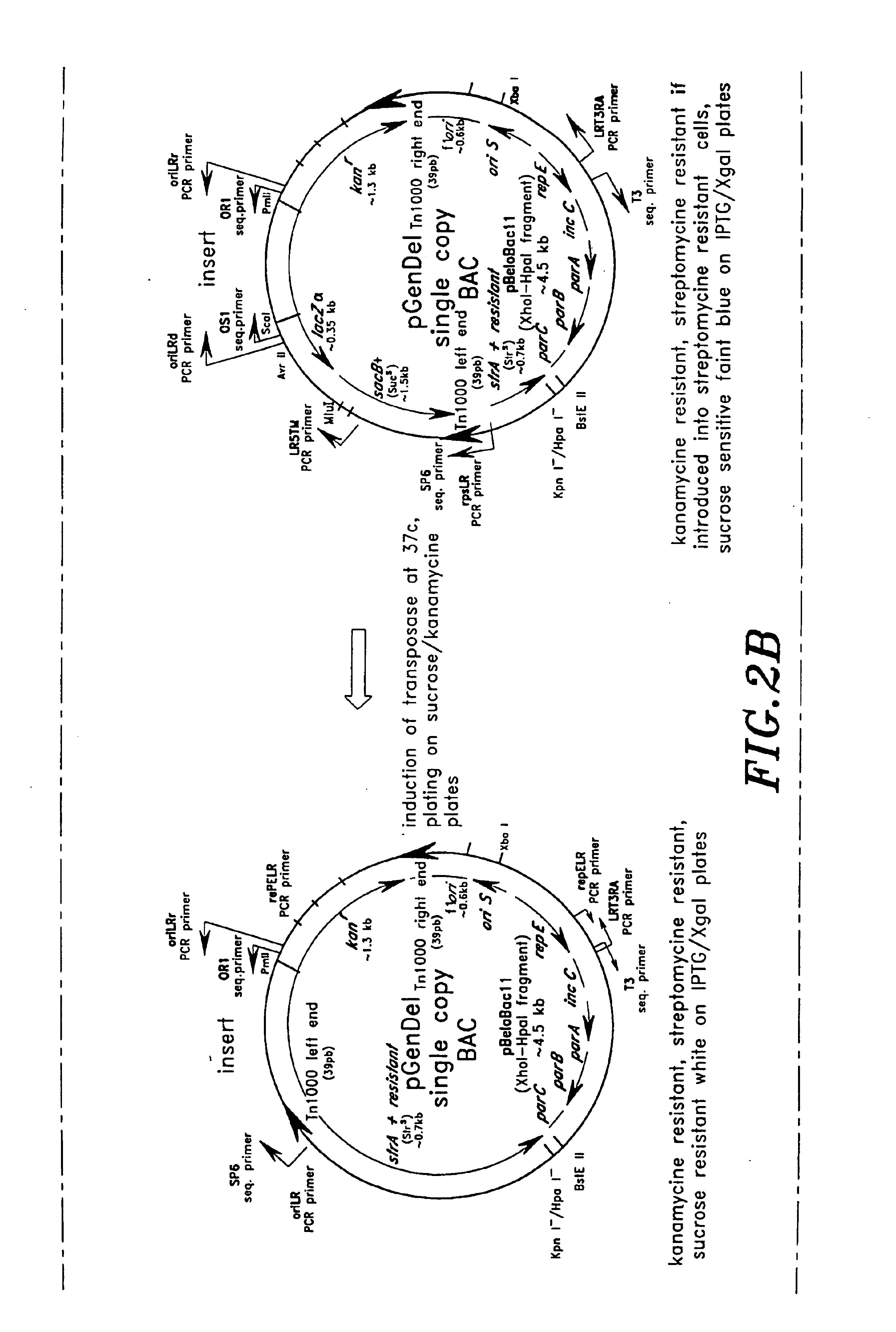High throughput DNA sequencing vector
a dna sequencing and high throughput technology, applied in the field of high throughput dna sequencing vectors, can solve the problems of large genome characterization and sequencing labor, large quantity of high quality, and existing transposon-based vectors designed for sequencing that require significant efforts
- Summary
- Abstract
- Description
- Claims
- Application Information
AI Technical Summary
Benefits of technology
Problems solved by technology
Method used
Image
Examples
example 1
[0256]A. Preparation of Insert DNA
[0257]A bacterial artificial chromosome (BAC) clone (B0166G11) containing a 145 kb human genomic DNA insert in pBeloBAC11 vector was grown overnight in LB broth containing 12.5 μg / ml of chloramphenicol. DNA was extracted by the alkaline lysis method and treated with RNAse. The supercoiled DNA band was isolated by Ethidium bromide / CsCl gradient centrifugation. Ethidium bromide was removed by passing the resulting material through Biorad AG50 resin. 3 μg of the resulting BAC DNA in 3 μl of 10 mM TrisHCl 1 mM EDTA pH 7.5 was sonicated using a XL2020 sonicator (available from Misonix) by 10 pulses of 0.5 second with 2 second intervals at maximum energy setting. The sonicated DNA was concentrated by Microcon 100 centrifugation. The concentrated DNA was size-fractionated by preparative 1% agarose gel electrophoresis. The resulting fractions of 4-6 kb size were excised and DNA was extracted by electroelution and subsequent concentration on Microcon 100 col...
example 2
[0284]Transposition based deletions were obtained from eight pGenDel1 sub-clones having the following inserts derived from the bacterial artifical chromosome clone BAC B0166G11:
[0285]B0166G11.D10, containing a 4200 bp insert
[0286]B0166G11.C03: containing a 5100 bp insert
[0287]B0166G11.D05: containing a 5300 bp insert
[0288]B0166G11.G06: containing a 5300 bp insert
[0289]B0166G11.D03: containing a 4500 bp insert
[0290]B0166G11.E07: containing a 4500 bp insert
[0291]B0166G11.A04: containing a 4200 bp insert
[0292]B0166G11.G05: containing a 5100 bp insert
[0293]These pGenDel1 subclones were obtained in cells containing pXRD4043 as described in Example 1 above. The pGenDel1 subclones were grown in 1 ml of LB containing 40 μg / ml kanamycin, and 12 μg / ml chloramphenicol at 30° C. overnight. After incubation for one hour at 37° C. to induce transposition, 4 μl of each resulting cell suspension was spread onto 140 mm Petri dishes containing 1% agar LB, 40 μg / ml kanamycin, 7.5% sucrose containing I...
example 3
[0306]Cells harboring sub-clone B180G09.H05 in pGenDel1 were cultured overnight in L Broth. 100 μl of this culture were centrifuged and the cells were resuspended in 1.25 ml of 10 mM TrisHCL pH 8.0, 1 mM EDTA. 8 μl of this solution were used to start a PCR reaction in a 50 μl total volume, with 20 pM each of the SLR3 and LRT3RA primers under the conditions recommended in the GeneAmp XL PCR kit (PE Applied Biosystems). The following cycles were performed on a PTC-200 (MJ RESEARCH) thermocycler.
[0307]A hot start was conducted at 94° C. for 3 minutes, during which Mg(Oac)2 was added. Denaturation proceeded for 15 seconds at 94° C. followed by 20 cycles of elongation for 13 minutes at 66° C. 15 cycles of elongation at 68° C., with an elongation time of 13 minutes and a ramp of 15 seconds per cycle were then conducted. Elongation was performed at 72° C. for 10 minutes.
[0308]This procedure gave from 1 to 5 μg of PCR product. The entire volume of the PCR reaction was diluted into 500 μl of...
PUM
| Property | Measurement | Unit |
|---|---|---|
| Light | aaaaa | aaaaa |
Abstract
Description
Claims
Application Information
 Login to View More
Login to View More - R&D
- Intellectual Property
- Life Sciences
- Materials
- Tech Scout
- Unparalleled Data Quality
- Higher Quality Content
- 60% Fewer Hallucinations
Browse by: Latest US Patents, China's latest patents, Technical Efficacy Thesaurus, Application Domain, Technology Topic, Popular Technical Reports.
© 2025 PatSnap. All rights reserved.Legal|Privacy policy|Modern Slavery Act Transparency Statement|Sitemap|About US| Contact US: help@patsnap.com



